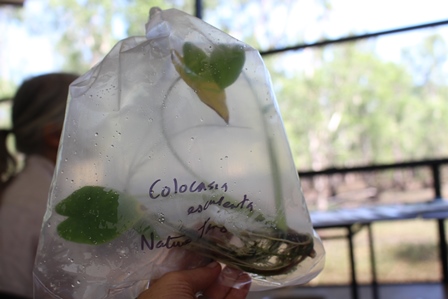 Aquatic-Weeds-Poster-2013_webLast Saturday a fantastic workshop was attended by over 30 Land for Wildlife members, held at Jasmin Jan’s beautiful 105 acre bush block, between Humpty Doo and Lambell’s lagoon. It was a pretty warm day, but the venue and serenity of the drying lagoon was very unique. We all now have rain and aquatics landscapes in mind, after being inspired by the talks and demos- so lets hope it rains soon!
Aquatic-Weeds-Poster-2013_webLast Saturday a fantastic workshop was attended by over 30 Land for Wildlife members, held at Jasmin Jan’s beautiful 105 acre bush block, between Humpty Doo and Lambell’s lagoon. It was a pretty warm day, but the venue and serenity of the drying lagoon was very unique. We all now have rain and aquatics landscapes in mind, after being inspired by the talks and demos- so lets hope it rains soon!

The block is in a horticultural zoning and was saved from being bulldozed about 12 years ago by local member Gerry Woods (and others). When it could not be used for horticulture it was sold in a private newspaper advert and Jasmin and her partner became the lucky owners. They have slowly built a dwelling and a studio over looking the large lagoon that takes up about 20 acres. They have worked tirelessly at managing the land, keeping it free of weeds and feral animals such as pigs, which damage the water margins and eat many water plants that other native animals rely on. Pig hunters can also be an issue and they try and keep these away too! There are still many cane toads, but the lagoon is a refugee to a huge number of native water birds, turtles, fish and many other animals. Jasmin feels very strongly about protecting native wildlife and the block is not fenced.

We started the workshop with a walk along the lagoon edge to see the different landscape types within the block and to hear about some of the management issues and tasks and enjoy the feel and composition of the land. We then came back to the art studio area, which is surrounded by wonderful art pieces inspired by nature and wildlife..

Dave Wilson, aquatic plant expert then gave us a talk about the various local aquatic plants used in ornamental or functional ponds, including native Taro (Colocasia esculenta) , an edible fern (Ceratopteris thalictroides) and many other wondrous plants of our waterways. His website www.aquagreen.com.au has stacks of information, species lists and articles.
 He also talked about the importance of not letting non native fish into our water systems and how to have a pond with non natives, if desired, and not let them into the local environment. A great point of interest was how to make natural swimming pools with various different filter plants . Dave has sent us a detailed document he wrote on Natural swimming pools. Click here to read it. They look amazing! This is an example below-
He also talked about the importance of not letting non native fish into our water systems and how to have a pond with non natives, if desired, and not let them into the local environment. A great point of interest was how to make natural swimming pools with various different filter plants . Dave has sent us a detailed document he wrote on Natural swimming pools. Click here to read it. They look amazing! This is an example below-

Belinda Townend from weeds branch and Greg Leach from Greening Australia then gave a presentation on aquatic weeds, how to identify them, how they spread and why they are good to manage, and what a view from the studio- over the lagoon!

After smoko, we had a fantastic session about propagation techniques from Yvette Brady and looked at marginal and other plants, sowing seed, but particularly at cuttings.


All topped off with lunch and a chance for members to meet each other. We can’t wait for the next workshop and would like to thanks Jasmin Jan for hosting and her constant support of the program and allowing us to use her art work in the website and promotions. We would also like to thanks all of our presenters who gave up their Saturday!

 Troy and Peter have been working on the 5 acre property in Leanyer over the last 2 years to restore it to native habitat, complete with beautifully landscaped paths using found rubble from the property. They also salvaged fill from construction sites and have planted over 500 plants. This hasn’t been easy and has involved a lot of hard work, removing vast amounts of Coffee bush, grassy weeds including Gamba and Mission Grass and concrete rubble; in fact many of the large native trees including beautiful Ghost gums and Milkwoods were only discovered on removal of the Coffee Bush.
Troy and Peter have been working on the 5 acre property in Leanyer over the last 2 years to restore it to native habitat, complete with beautifully landscaped paths using found rubble from the property. They also salvaged fill from construction sites and have planted over 500 plants. This hasn’t been easy and has involved a lot of hard work, removing vast amounts of Coffee bush, grassy weeds including Gamba and Mission Grass and concrete rubble; in fact many of the large native trees including beautiful Ghost gums and Milkwoods were only discovered on removal of the Coffee Bush.













